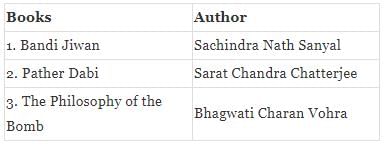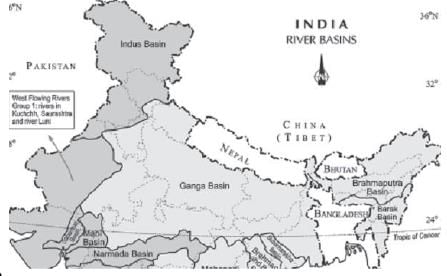UPSC CSE Prelims Paper 1 (GS) Mock Test - 21 (June 4, 2021) - UPSC MCQ
30 Questions MCQ Test - UPSC CSE Prelims Paper 1 (GS) Mock Test - 21 (June 4, 2021)
Consider the following statements about the Regulating Act of 1773:
1. It subsumed the presidencies of Madras and Bombay under Bengal's control.
2. The Company’s territories in India were termed ‘British possessions’.
3. It allowed the servants of the Company to engage in private trade.
Which of the statements given above is/are correct?
1. It subsumed the presidencies of Madras and Bombay under Bengal's control.
2. The Company’s territories in India were termed ‘British possessions’.
3. It allowed the servants of the Company to engage in private trade.
Which of the statements given above is/are correct?
Consider the following statements with reference to the fuel cell electric vehicles:
(1) It creates electricity through an electrochemical process of combining hydrogen and oxygen where water is the only byproduct.
(2) It is always combined with a conventional internal combustion engine running on petrol/diesel.
Which of the statements given above is/are correct?
(1) It creates electricity through an electrochemical process of combining hydrogen and oxygen where water is the only byproduct.
(2) It is always combined with a conventional internal combustion engine running on petrol/diesel.
Which of the statements given above is/are correct?
| 1 Crore+ students have signed up on EduRev. Have you? Download the App |
Which of the following modifications can be seen in Mangroves that help them survive to waterlogged conditions?
1. Aerial roots
2. Viviparity mode of reproduction
3. Salt glands in leaves
4. Lenticellated bark
Select the correct answer using code given below.
1. Aerial roots
2. Viviparity mode of reproduction
3. Salt glands in leaves
4. Lenticellated bark
Select the correct answer using code given below.
Which of the following plate (s) is / are parts of Gondwana Land?
1. South American plate
2. African plate
3. Indo-Australian plate
4. Antarctic plate
Select the correct answer using the code given below:
Which of the following sets of pair(s) is/are correctly matched?

Select the correct answer using the code given below:
Which of the following statements correctly describes NEONs, which was in the news recently?
Under the constitution, a person shall be disqualified for being elected as a member of parliament if
1. He holds any office of profit
2. He is found guilty of a certain election offense
3. He fails to lodge an account of his election expenses within stipulated times
4. He is an undischarged insolvent.
Select the correct answer using the code given below.
The Amazon rainforest is spread in which of the following countries?
1. Brazil
2. Peru
3. Colombia
4. Chile
Select the correct answer using the code given below.
Which of the following was nicknamed “The Gagging Act”:
Consider the following statements regarding the ‘IndiGen Genome’ Project:
(1) It deals with genome sequencing, which is ordering the DNA nucleotides such as Adenine, Guanine, Cytosine and Uracil.
(2) It is being implemented by the World Health Organization (WHO) in India with funding support from the World Bank.
Which of the statements given above is/are correct?
With reference to the Standing Committee on Finance, consider the following statements:
1. It examines the financial matters concerned with all the ministries and departments of the Government of India.
2. The Chairman of the Committee is appointed by the Speaker from amongst the members of the Committee from Lok Sabha.
Which of the statements given above is/are correct?
With reference to Northern Plains of India, consider the following statements:
1. The Northern Plains are generally characterized as flat land with no variations in relief.
2. The largest portion of Northern Plain is formed of older alluvium.
Which of the statements given above is / are correct?
Consider the following regarding the Wood’s Despatch (1854):
1. It suggested to educate only a small section of upper and middle classes in line with Macaulay’s minutes.
2. It recommended English as the medium of instruction for higher studies and vernaculars at school level.
3. It laid stress on female and vocational education, and on teachers’ training.
Which of the statements given above is/are correct?
Consider the following statements with respect to the Inner Line Permit (ILP):
(1) It is a travel document to allow inward movement of an Indian citizen into a protected area for a limited period.
(2) The Ministry of Home Affairs issues it.
(3) At present, it is operational in the states of Arunachal Pradesh, Manipur and Nagaland.
Which of the statements given above is/are not correct?
Consider the following Indian states:
1. Haryana
2. Madhya Pradesh
3. Rajasthan
4. Chhattisgarh
Which of the states given above are part of the Ganga River Basin?
Consider the following statements about the Motor Vehicle Act , 2019:
1. Offence committed by Juveniles is to be tried under Juveniles Justice Act and not under this Act .
2. If a contractor of the road fails to comply with road design standards , then there will be penalty on the road contractor.
3. If a vehicle manufacturer fails to comply with motor vehicle standards, then there will be penalty on the Vehicle manufacturer.
4. The central government will develop a scheme for cashless treatment of road accident victims during golden hour.
Which of the statements given above are correct?
Consider the following statements about National Knowledge Network (NKN):
1. It aims to connect all universities, research institutions, libraries and agricultural institutions across the country.
2. Agencies in the fields of nuclear, space and defence research are also part of NKN.
3. Its goal is to facilitate distance education in engineering, science and medicine.
Which of the statements given above is/are correct?
Which of the following statements is not correct regarding ‘National Anti-Profiteering Authority (NAA)’?
Consider the following statements regarding the writ of Certiorari:
1. It is issued by a higher court to a lower court to transfer a case pending with the latter to itself or to quash the order of the latter in a case.
2. It can be issued against judicial as well as administrative authorities affecting the rights of individuals.
Which of the statements given above is/are correct?
Which one of the following condition is referred as ‘Continentality’?
Which of the following was called the “liberator of the Indian press”:
Which of the following is/are not necessarily the consequences of invocation of the President’s Rule in a State because of the inability of political parties to form a government after the State Assembly elections?
(1) Imposition of direct rule of the Centre.
(2) Dissolution of the newly elected State Assembly.
Select the correct answer using the code given below.
Income distance criteria used by 15th Finance Commission refers to:
With reference to the Indian Monsoon, consider the following statements:
1. The monsoon winds cover the entire India in about a month.
2. Whenever the axis of monsoon trough shifts closer to the Himalayas, there is longer and abundant rainfall in the Northern Plains of India.
Which of the statements given above is / are correct?
Which of the following sets of pair(s) is/are correctly matched?

Select the correct answer using the code given below:
Which of the following statements are correct about India’s East Coast Economic Corridor (ECEC)?
(1) It is India’s first coastal economic corridor.
(2) Asian Development Bank is the lead partner in this project.
(3) It extends from Kolkata to Mahe in Puducherry.
Select the correct answer using the code given below.
Consider the following pairs:

Which of the pairs given above is/are correct?
If a ship travels along the Sea lines of Communication from Hong Kong to Abu Dhabi, which of the following straits will be crossed by that ship assuming it moves along the shortest possible route?
1. Hormuz Strait
2. Cook Strait
3. Gibraltar Strait
4. Malacca Strait
Select the correct answer using the code given below.
With reference to Raja Rammohan Roy, which of the following statements is/are correct?
1. He was a firm believer of free cooperation between nations.
2. He demanded the separation of executive and judiciary.
3. He was the founder of the Hindu College.
Select the correct answer using the code given below:
Which of the following statements is not correct with respect to Nutrient Based Subsidy (NBS) for fertilisers in India?



















